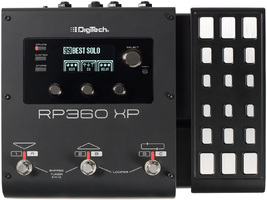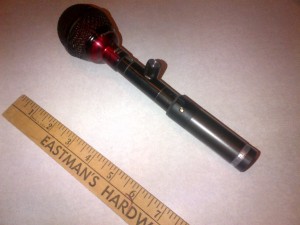
Recording My First Country Session With the RP360XP
No, this isn’t about recording my first country session, just the first one with the Digitech RP360XP.
I got an email earlier this week from a producer from Austin named Bobby Flores who I’ve worked with on several occasions. Bobby asked if I was available to do a few tracks for a male artist he’s producing. Not long after, I downloaded a couple of rough mp3 mixes of two songs, and set to work recording harp parts for them.
The Process for Session Work at Home Starts and Ends on the Internet
Except for the recording process, the business I do with producers in my home studio is conducted almost entirely via the Internet. The producer sends me mp3s along with any notes on what’s desired in the performance(s). I load the mp3s into my recording software, which is Cakewalk Sonar X3, listen to them, and take notes on the song structures, the emotions and ideas, and how I can address those things with the harp. Then I do a take or two for each song, mix those with the mp3s, and send the new rough mixes to the producer for approval and/or suggestions. If necessary, I’ll do another take, and repeat the process. Once a take is approved, I get paid (usually via Paypal), and I send a solo’d harp track (in whatever format the producer specifies–my default is 24-bit 44.1 kHz WAV) to the producer via Hightail.com, or Dropbox, or whatever Internet service is preferred.
The whole process is very effective, efficient, and enjoyable (especially since I replaced my general purpose laptop with a piece designed for music, the Studio Cat Laptop Pro). Recording directly to the computer via USB with the RP360XP is so, so easy; the setup takes practically zero time, and my patch set for RP360XP gives me a huge pile of distinctive sounds to work with. For stage performance I prefer the RP500 because of its big set of footswitches that makes changing the sound quick and easy. For recording, those kinds of fast pivots from one sound to another usually aren’t required. The RP360XP is also easier to set up than the RP500, because it’s smaller and lighter, and the RP360XP just sounds fabulous on any recording. 
I feed the 360XP with an Audix Fireball V mic, which I hand-hold to eliminate room sounds from the recording. The handheld Fireball produces a beautifully clean, clear, full sound all by itself, no additional processing required. When the recording calls for acoustic harmonica–which this one did–I just turn off the reverb on one of my Direct amp-modeled patches. The Direct amp model essentially takes whatever is presented at the input, makes it louder or softer as desired, and sends it to the output (with any other FX processing in the RP’s chain in between, of course; in this case that’s none). 
Here’s what it sounds like
The RP360XP sends a 24-bit (read: pro-level) signal to the computer with no noise or artifacts that I can hear. Coupled with the Fireball, it’s perfect for acoustic harp tracks. Here’s a short acoustic harp phrase from this session so you can hear what the setup sounds like, at least with me playing:
For this session, I did acoustic tracks in this way for both songs, and a couple of takes on one song with a Blackface Deluxe patch that’s included in my RP360XP patch set under the name “BDBlue.” That patch has a sweetly amped-up sound, full and punchy without being too wildly distorted. I was a little concerned about using any amp modeling for a country song, but the tune itself had a pretty crunchy guitar hook, and I hear a lot of classic rock tones in Country music nowadays, so I thought I’d give the producer a chance to hear the harp rock out on the piece. Here’s what that patch sounded like on this session:
A few hours’ work gets it done
It took a half hour or so to get everything set up to record, an hour and a half to do a half-dozen takes between the two songs, and a half hour to get everything ready to send to Bobby. When I recorded the takes, I used a Seydel 1847 in G and a Suzuki Manji in D, and I tried to avoid playing too much bluesy stuff; country harp uses the same techniques as blues, but not in the same ways, and I didn’t want to send Bobby tracks that weren’t country enough. Bobby had also told me to play the tracks the way I heard them, so I wanted not to play it too safe, either. I ended up playing pretty traditionally on one of the songs, and taking more chances with the style on the other.
After sending Bobby the tracks I waited a day to hear back from him, at which point he emailed me to say that he loved the tracks. He wanted me to add the guitar lead-ins for both songs to my tracks, so he could synchronize them more easily, and he asked me to clear up a couple of extraneous noises on one of the tracks. He paid me, and I made all the necessary edits in another hour, at which point I sent the files via Hightail.
There are probably another couple of songs coming up for this artist soon. I’ll look forward to recording them with this setup.
Tags In
Related Posts
Leave a Reply
You must be logged in to post a comment.
WHAT’S NEW
Categories
- Audio/Video
- Blog
- Blue Future
- Digitech RP Tricks and Tips
- Discography, CDs, Projects, Info, Notes
- Featured Video
- For the Beginner
- Gallery
- Hunter's Effects
- Hunter's Music
- Huntersounds for Fender Mustang
- Meet the Pros
- More Video
- MPH: Maw/Preston/Hunter
- My Three Big Contributions
- Player's Resources
- Pro Tips & Techniques
- Recommended Artists & Recordings
- Recommended Gear
- Recorded Performances
- Reviews, Interviews, Testimonials
- The Lucky One
- Uncategorized
- Upcoming Performances
- Zoom G3 Tips and Tricks